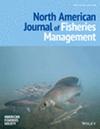1993-2022 年苏必利尔湖瘦湖鳟鱼种群恢复的最新研究和属性综述
IF 1.4
4区 农林科学
Q3 FISHERIES
引用次数: 0
摘要
本文旨在描述苏必利尔湖中已恢复的湖鳟鱼 Salvelinus namaycush 种群的特征,描述其种群动态、生态以及自 1993 年宣布湖鳟鱼恢复以来的最新研究和管理活动。方法综合并报告来自商业渔业、休闲渔业、机构放养报告、自然资源机构独立于渔业的调查数据,以及 1993 年至 2022 年期间发表的有关苏必利尔湖瘦肉型湖鳟的研究结果。结果目前,湖鳟种群可自我维持,开发程度较低,只有少数地区的总死亡率较高。年总死亡率远低于 42-45% 的最大目标范围。结论我们从研究和管理经验中了解到,湖鳟在五大湖中的调节作用对生态系统的正常功能至关重要。因此,自然资源机构需要继续致力于合作并实施有效的管理行动,以保持湖鳟种群在整个湖区恢复的成就。本文章由计算机程序翻译,如有差异,请以英文原文为准。
Synthesis of recent research and attributes of recovered lean Lake Trout populations in Lake Superior, 1993–2022
ObjectiveThis purpose of this paper is to describe the characteristics of recovered Lake Trout Salvelinus namaycush populations in Lake Superior by describing its population dynamics, ecology, and recent research and management activities since 1993, when Lake Trout were declared rehabilitated.MethodsData from commercial fisheries, recreational fisheries, agency stocking reports, and natural resource agency fishery‐independent survey data along with published research findings on lean Lake Trout in Lake Superior between 1993 and 2022 were synthesized and reported.ResultCurrently, Lake Trout populations are self‐sustaining and lightly exploited with only a few areas with elevated total mortality rates. The total annual mortality has been far below the target maximum range of 42–45%. Furthermore, stocking of hatchery Lake Trout is no longer necessary.ConclusionWe have learned from research and management experience that the regulatory role of Lake Trout in the Great Lakes is critical to proper ecosystem function. Thus, continued commitment from natural resource agencies to cooperate and implement effective management actions is required to preserve the accomplishments of lakewide recovery of Lake Trout populations.
求助全文
通过发布文献求助,成功后即可免费获取论文全文。
去求助
来源期刊
CiteScore
2.60
自引率
18.20%
发文量
118
审稿时长
2 months
期刊介绍:
The North American Journal of Fisheries Management promotes communication among fishery managers with an emphasis on North America, and addresses the maintenance, enhancement, and allocation of fisheries resources. It chronicles the development of practical monitoring and management programs for finfish and exploitable shellfish in marine and freshwater environments.
Contributions relate to the management of fish populations, habitats, and users to protect and enhance fish and fishery resources for societal benefits. Case histories of successes, failures, and effects of fisheries programs help convey practical management experience to others.

 求助内容:
求助内容: 应助结果提醒方式:
应助结果提醒方式:


